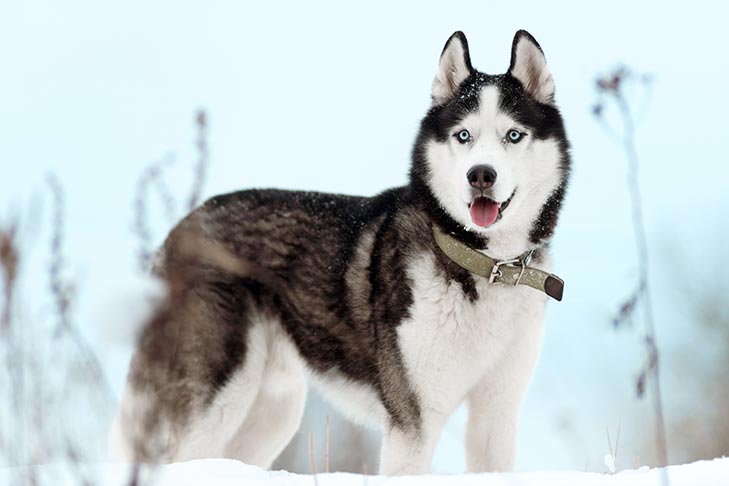
AKC is a participant in affiliate advertising programs designed to provide a means for sites to earn advertising fees by advertising and linking to akc.org. If you purchase a product through this article, we may receive a portion of the sale.
Have you ever noticed that your dog’s mood shifts with the weather? Storms, heat, cold, and the changing seasons affect our dogs, just like they affect us. Most dogs can even sense when the weather is about to change.
But how does hot weather affect dogs, and how does cold weather affect dogs? Understanding the impact of these changes on your dog can help you prepare your canine companion for the forecast ahead.
Changing Seasons
How does hot weather affect dogs? When the temperature heats up, some dogs rejoice, while others seek out cool, shady spots where they can rest. Though all dogs can be susceptible to hot weather hazards, certain dog breeds may be less heat-tolerant than others.
Brachycephalic breeds, such as Bulldogs, French Bulldogs, Pugs, and Boston Terriers, do best when staying cool in hot weather because they can have difficulty breathing in extreme heat. Large breeds are also susceptible to heat, as are longhaired breeds like the Komondor, Afghan Hound, and Alaskan Malamute. If you own a breed like these, you may find that your dog is not as active in hot weather or as willing to engage in play and other activities.
Some dogs may even get snappish in very hot weather and may want more space and less petting. A group of researchers in Beijing, China found that the frequency of emergency room visits for dog bites in a major hospital increased when temperatures were highest. In very hot weather, you may want to minimize interactions between your dog and strangers, including children.

How does cold weather affect dogs? Colder climates, on the other hand, are where Northern breeds like American Eskimo Dogs, Samoyeds, and Siberian Huskies thrive. Longhaired or double-coated breeds like German Shepherd Dogs, Saint Bernards, Great Pyrenees, and Newfoundlands typically enjoy cooler weather, too. They often become more active and playful during the winter months.
In contrast, some dogs, such as Italian Greyhounds, Greyhounds, hairless breeds, toy breeds, senior dogs, and dogs with conditions such as hypothyroidism, Cushing’s disease, or arthritis, may become less active or playful during winter months.
Relocating to a New Climate
Seasons usually change gradually, giving your dog time to adjust. Relocating to an entirely new climate, however, can cause sudden shifts in your pup’s mood. Depending on your dog’s breed, you may notice that they become more or less active, and some dogs even show signs of irritation if the weather makes them too uncomfortable.
A move to a cold climate can be shocking for dogs that are not used to chilly temperatures. Some pups seek out warm places, like heating vents, blankets, or your bed, and you might notice your canine companion becoming cuddlier in the cold.
Whether it’s hot or cold, understanding the cause of your dog’s sudden lethargy or increased activity level can help you determine if the change in mood is circumstantial or medical. Lethargy is a common symptom of many illnesses and should be taken seriously, so make sure your dog is not exhibiting any other abnormal signs. If they are, consult your veterinarian immediately.
Helping Your Dog Adjust
If your dog gets grumpy in the heat, don’t worry. There are things you can do to make them more comfortable and lower their risk of heatstroke.
- Avoid taking your dog for walks during the hottest parts of the day.
- Make sure they have plenty of fresh water and shade available at all times.
- Raised canvas platform dog beds offer a cooling alternative to traditional beds, and you can even invest in cooling mats or dog-friendly swimming pools for particularly heat-intolerant dogs.
- If you don’t have air conditioning, adjust a fan so that your dog has access to a nice, cool breeze.
- Never leave a dog unattended in an enclosed vehicle or in a warm environment that does not have good air circulation.
- Beware of walking your dog over hot sidewalks, streets, sand, or other hot surfaces.
- Although swimming is a great way to get exercise on a hot day, and most dogs can swim, never leave your dog unsupervised around a pool or in any body of water.

You can also help your dog acclimate to the cold. Put a limit on outdoor time, and be sure to clean the salt and ice balls off of your dog’s paws when you come inside.
Depending on your dog’s coat type, you might also want to dress them in something warm. With so many dog sweaters, jackets, raincoats, and booties to choose from, keeping your dog warm is easier than ever. However, it’s important to note that you should never leave an item of clothing on an unsupervised dog. And anything you do put on your canine companion should fit properly (not too tight or too loose).
This article is intended solely as general guidance, and does not constitute health or other professional advice. Individual situations and applicable laws vary by jurisdiction, and you are encouraged to obtain appropriate advice from qualified professionals in the applicable jurisdictions. We make no representations or warranties concerning any course of action taken by any person following or otherwise using the information offered or provided in this article, including any such information associated with and provided in connection with third-party products, and we will not be liable for any direct, indirect, consequential, special, exemplary or other damages that may result, including but not limited to economic loss, injury, illness or death.

